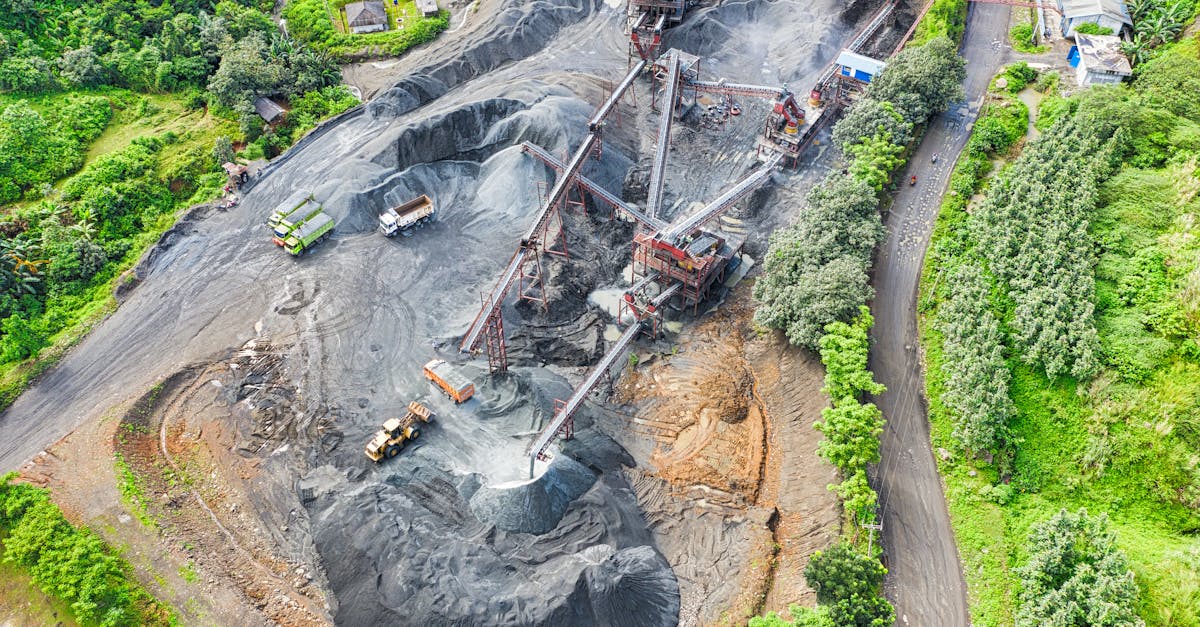Harnessing Technology for Mining’s Golden Age

Unleashing the Power of Advanced Mining Technologies: Embracing Automation, AI, and Innovation
The mining industry is on the cusp of a technological revolution, with advanced technologies like automated robotic systems, drones, and artificial intelligence (AI) poised to transform every aspect of operations. By embracing these cutting-edge solutions, mining companies can unlock unprecedented potential in areas such as exploration, extraction, environmental monitoring, and data analytics.
The integration of automated systems and AI promises to redefine mining practices, enhancing safety, boosting productivity, reducing environmental impact, and empowering data-driven decision-making. As the industry continues to navigate evolving market demands and sustainability pressures, advanced technologies offer a transformative pathway towards a future-ready mining sector.
Key Insights
- Advanced technologies such as automation, AI, and drones are transforming every aspect of mining operations, from exploration to extraction to environmental management.
- Automated robotic systems and drones are enhancing safety, boosting productivity, and optimizing resource recovery in mining operations.
- AI is revolutionizing gold exploration by providing powerful tools for data analysis and target identification, leading to more precise and efficient exploration.
- Drones and AI are emerging as powerful tools for environmental monitoring in mining, helping companies to ensure compliance, reduce environmental impact, and promote sustainability.
- Data analytics is playing an increasingly important role in mining, providing companies with the insights they need to make informed decisions and improve their performance.
1. The Dawn of Automated Mining: Unlocking New Possibilities
The mining industry is embracing a new era of automation, with robotic systems and drones taking center stage. These advanced technologies are transforming every aspect of mining operations, from exploration and extraction to environmental monitoring and data analysis.
Automated robotic systems are equipped with precision sensors and advanced algorithms, enabling them to perform tasks with accuracy and efficiency unmatched by human capabilities. They can navigate complex underground environments, operate heavy machinery, and even make autonomous decisions. Drones, on the other hand, provide aerial support, capturing high-resolution images and data from труднодоступных areas. They are particularly valuable for surveying large mining sites, monitoring environmental impact, and delivering supplies to remote locations.
The benefits of automated mining technologies are multifaceted. They enhance safety by removing humans from hazardous environments, increase productivity through 24/7 operations, and optimize resource recovery by accessing previously inaccessible areas. Moreover, these technologies generate vast amounts of data, which can be analyzed to improve decision-making and optimize mining processes.
2. Enhanced Exploration with AI: Precision and Efficiency

Enhanced Exploration with AI: Precision and Efficiency
Artificial intelligence (AI) is revolutionizing gold exploration by providing powerful tools for data analysis and target identification. AI algorithms can process vast amounts of geological data, including satellite imagery, geophysical surveys, and drill core samples, to identify patterns and anomalies that may indicate the presence of gold deposits.
One of the key benefits of AI in gold exploration is its ability to analyze data more accurately and efficiently than traditional methods. AI algorithms can sift through large datasets, identifying subtle patterns and correlations that may be missed by human geologists. This leads to more precise target identification, reducing the risk of drilling in unproductive areas.
AI is also transforming the way geologists interpret data. By using machine learning techniques, AI can identify patterns and relationships in data that are not immediately apparent to humans. This can lead to new insights into the geological processes that formed gold deposits and help geologists to identify new exploration targets.
3. Revolutionizing Extraction: Automated Systems for Increased Safety and Productivity
Automated robotic systems are playing an increasingly vital role in mining extraction processes, enhancing safety, boosting productivity, and optimizing resource recovery. These systems can perform a wide range of tasks, from operating heavy machinery to transporting materials, with precision and efficiency that surpass human capabilities.
One of the primary benefits of automated robotic systems in extraction is improved safety. By removing humans from hazardous environments, such as underground mines or near heavy machinery, these systems reduce the risk of accidents and injuries. They can also be equipped with sensors and cameras to monitor conditions in real-time, detecting potential hazards and taking appropriate action.
Automated robotic systems also enhance productivity by operating 24/7, without the need for breaks or rest. They can perform repetitive tasks with consistent accuracy, maximizing resource recovery and reducing waste. Additionally, these systems can be programmed to optimize extraction processes, such as adjusting drilling patterns or conveyor speeds, based on real-time data analysis.
4. Environmental Monitoring: Drones and AI for Sustainable Operations

Environmental Monitoring: Drones and AI for Sustainable Operations
Drones and AI are emerging as powerful tools for environmental monitoring in mining operations, helping companies to ensure compliance, reduce environmental impact, and promote sustainability. Drones can be equipped with sensors and cameras to collect high-resolution data on air quality, water quality, and land use. This data can then be analyzed using AI algorithms to identify potential environmental issues and develop mitigation strategies.
One of the key benefits of using drones and AI for environmental monitoring is the ability to collect data in real-time. This allows mining companies to respond quickly to environmental incidents and take proactive measures to minimize their impact. For example, drones can be used to detect methane leaks from pipelines or monitor water quality in tailing ponds.
AI can also be used to analyze historical and real-time data to identify trends and patterns in environmental data. This information can be used to develop predictive models that can forecast potential environmental impacts and help mining companies to plan and operate their operations in a more sustainable manner.
5. Data Analytics: Empowering Informed Decisions with Real-Time Insights
Data analytics is playing an increasingly important role in mining operations, providing companies with the insights they need to make informed decisions and improve their performance. By leveraging AI to analyze vast amounts of operational data, mining companies can identify trends, patterns, and anomalies that would be difficult to detect manually. This information can be used to optimize production processes, reduce costs, and improve safety.
One of the key benefits of data analytics in mining is the ability to monitor and analyze operations in real-time. This allows mining companies to identify and address potential issues before they become major problems. For example, data analytics can be used to track equipment performance, predict maintenance needs, and monitor inventory levels.
Data analytics can also be used to improve decision-making in the mining industry. By analyzing historical data and identifying patterns, mining companies can develop predictive models that can forecast future outcomes. This information can be used to make more informed decisions about everything from production planning to investment strategies.
6. Embracing Innovation: Case Studies of Successful Implementations
Embracing Innovation: Case Studies of Successful Implementations
Mining companies around the world are embracing advanced technologies to improve their operations and gain a competitive advantage. Here are a few real-world examples of successful technology implementations in the mining industry:
- BHP Billiton’s use of autonomous trucks: BHP Billiton, one of the world’s largest mining companies, has successfully implemented autonomous trucks at its iron ore mines in Western Australia. These trucks are equipped with sensors and cameras that allow them to operate without human drivers, resulting in improved safety and productivity.
- Rio Tinto’s use of AI for predictive maintenance: Rio Tinto, another global mining giant, is using AI to predict maintenance needs for its equipment. By analyzing data from sensors on its equipment, Rio Tinto can identify potential problems before they become major breakdowns, reducing downtime and maintenance costs.
- Vale’s use of drones for environmental monitoring: Vale, a Brazilian mining company, is using drones to monitor the environmental impact of its operations. These drones are equipped with sensors that can collect data on air quality, water quality, and land use. This data is then used to develop mitigation strategies and ensure compliance with environmental regulations.
7. Future Trends: Anticipating the Next Wave of Advancements
Future Trends: Anticipating the Next Wave of Advancements
The mining industry is on the cusp of a new wave of advancements, driven by emerging technologies such as automation, AI, and sustainability. These technologies are expected to transform every aspect of mining operations, from exploration to extraction to environmental management.
One of the most significant trends in the future of mining is the increasing adoption of automation. Autonomous mining systems, such as self-driving trucks and drones, are already being used in some mines, and their use is expected to expand in the coming years. Automation has the potential to improve safety, productivity, and efficiency in mining operations.
AI is also playing an increasingly important role in mining. AI algorithms can be used to analyze vast amounts of data to identify trends, patterns, and anomalies. This information can be used to improve decision-making, optimize processes, and predict future outcomes. AI is expected to have a major impact on the mining industry in the coming years, as it becomes more sophisticated and accessible.
Sustainability is another key trend in the future of mining. Mining companies are under increasing pressure to reduce their environmental impact and operate in a sustainable manner. This is driving the development of new technologies and practices that can minimize the environmental footprint of mining operations.
What are the key benefits of using advanced technologies in mining?
The key benefits of using advanced technologies in mining include improved safety, increased productivity, reduced environmental impact, and enhanced decision-making.
How is AI being used in the mining industry?
AI is being used in the mining industry to analyze data, identify trends, predict outcomes, and optimize processes. It is also being used to develop autonomous mining systems and improve environmental monitoring.
What are the future trends in the mining industry?
Future trends in the mining industry include the increasing adoption of automation, AI, and sustainable practices. These technologies are expected to transform every aspect of mining operations, from exploration to extraction to environmental management.
Key Insights
| Key Insight | Description | |—|—| | Advanced technologies are transforming mining operations | Automation, AI, and drones are being used to improve safety, boost productivity, and optimize resource recovery. | | AI is revolutionizing gold exploration | AI algorithms can analyze large datasets to identify patterns and anomalies that may indicate the presence of gold deposits, leading to more precise and efficient exploration. | | Drones and AI enhance environmental monitoring | Drones and AI can collect data on air quality, water quality, and land use, helping mining companies to ensure compliance, reduce environmental impact, and promote sustainability. | | Data analytics empowers informed decision-making | Data analytics can be used to analyze operational data and identify trends, patterns, and anomalies, providing companies with the insights they need to make informed decisions and improve their performance. |

0 responses to “Unleashing the Power of Advanced Mining Technologies: Automated Robotic Systems, Drones, and AI”